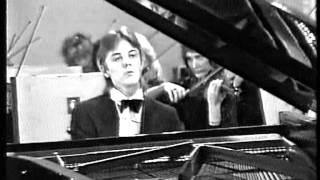
Secret WW2 Projects | The First U.S. Jet, And The British Engine | Aviation History Documentary
Комментарии:

Can't wait to fully digest this one this evening, thanks for the great content!
Ответить
Lutterworth is and was then a Town not a village.
Ответить
Excellent
Ответить
It's fantastic having Sir David narrate this fine piece of educational material.
Ответить
Hap Arnold's visit to England in 1941 had a purpose, one that was not revealed.
Nathan Price and Kelly Johnson had tried to promote an axial flow jet engine to the skeptical General.
So, Hap went to England and asked: "Do you think there is anything to all the talk about Jet engines?
To which the British replied: "Would you like to see one?"
Hap turned to Kelly and told him to develop the technology as soon as possible. When asked what he would need, Kelly's reply was what we now know as a "Skunk Works."
A decade earlier, Nathan Price, who had been intrigued by the efficiency of steam turbines, joined the Doble steam company to learn as much as he could about a technology invented by Charles Parsons in 1884.
Thirteen years later, his Turbinia amazed the British Navy with its turbine power which was vastly more efficient than engines with reciprocating pistons.
Combine the idea with Deltic engines that operated with diesel or steam pistons. Could that apply to turbines?
The working fluid for steam engines requires an understanding of the enthalpy changes in a closed circuit steam cycle.
A gas turbine engine was similar, but burning fuel replaces water as the working fluid.
That's what Nathan Price did while developing detailed plans for the Lockheed L123 and its two axial-flow L1000 engines. It would have been 50 mph faster than the Me 262 but with less than an hour of flight time.
The jet engines of WW2 lacked an essential feature that later made them vastly more useful.
Gerhard Newman, head of GE's Jet Aircraft engine division in Lynn, MA invented a way to alter the compressor stator blades, to avoid compressor stalls during power changes.
The first time GE tried the British engine with that feature, the engine blew apart.
It meant the engine was capable of far more power with his device, and all they needed was to build an engine that could contain the power the engine could deliver.
Another avenue to the potential of jet technology can be seen in the Garrett Air Research turbo-chargers that use hot exhaust gas to maintain cabin pressure at altitude, as well as to increase intake manifold pressure to preserve power in thin air.
Simplified schematics shows there’s no need for pistons in a carefully engineered design.
--- Simpler, lighter, more efficient, fewer components and far less maintenance.

Sir Frank Whittle , what an eloquent speaker .
Ответить
Anyone going to Lutterworth to see a jet engine in 1937 or 1938 would have been quite disappointed as Power Jets was based in Rugby at the time with the workshop at BTH.
Ответить
I wish they'd covered the giving away by the British government of Sir Frank's patent to the Americans. A lot of people in Britain were very unhappy about that.
Ответить
My colleague Ben, his Dad worked power jets, he looks like the grumpy guy with glasses in the Whittle test bed footage, always assumed it was his Dad.
Ответить
Propellers are not obsolete, cfm rise?
Ответить
What a marvelous man!
Ответить
One thing that’s missed from commentaries is any mention of the metallurgy breakthroughs that made these leaps possible.
Ответить
Their were many new technologies in the package that the British gave to the USA free of charge in early 1940 with the Tizard Missions not just the massive gift of jet engines. The more combat important Cavity Magnetron that created short wave radars allowing fitment of radar on ships and aircraft. Midway in 1942 and other sea battles were won because of this radar and the foresight of Admiral Johnson and long range air navigation systems like 'LORAN' were made possible by the UK's Magnetron. According to James Phinney Baxter III, Official Historian of the Office of Scientific Research and Development: "When the members of the Tizard Mission brought one cavity magnetron to America in 1940, they carried the most valuable cargo ever brought to our shores."
In hindsight the gift of jet engines to the USA had zero effect on the the result of WWII especially as the Meteor was far better than anything produced by the USA even up to 1950. And contrary to what was inferred in the video the Meteor was actually the first OPERATIONAL jet fighter in July 1944. BUT it gave the massive manufacturing capabilities of the USA a major advantage post WWII as they only paid licencing fees to manufacture (and then blatantly copy) and not pay the full price of engines built in the UK. Imagine the global market hold the UK would have had into the '50s and '60s.

What a fantastic looking plane. Looks really great for the first one.
Ответить
This was the perfect example of the American obsession with over secrecy, compartmentalization, and classifying everything to the detriment of progress. If they had allowed the Bell Corp. access to the wind tunnels early on in the process they may have had a winner of not only the first jet fighter but a tactical superior machine.
I read somewhere, as surprising as it sounds, seventy percent of all printed documents that are generated by the United States government today and classified at some level.

Why they used a british engine in their projects ? Because they aren't an american jet engine project beiing developed yet...
Ответить
Is this Richard Harris narrating? Sure sounds like him.
Ответить
Sobering to hear that if one person hadnt had defective eyesight we may never have had the jet engine, and we possibly would all be speaking German
Ответить
The XP-59’s not too much of a looker, ya?
Ответить
Tex Johnson - if only he knew he’d be barrel rolling jet powered airliners later in his career.
Ответить
Many years ago (1964) as an inquisitive lad I asked my Grandmother if I could fiddle with some old clocks she had in a box, fascinated by all those gears and things she explained what bit did what and went on to tell me about her watch repair shop 'Harvers'. I asked what sort of things they fixed and she said all sorts of things then told me about the old boy in the workshop who made clock parts then said 'young Frank would sometime bring in a box of gauges to fix and fittings needing silver soldering or brazing. I asked "who is Frank" she casually replied "oh he's the chap that invented the jet engine' ! . I was too young to appreciate young Franks contribution by I like to think Gran's shop played a little part in the jet's development.
I also didn't know that the nice picture of a plane at my Uncles flat I had scribbled on were in fact GA plans of Mitchell's 'Spitfire' . He also had a nice Balsa plane on his desk that I would zoom around the room with. Yep that was a wind tunnel model of the Spit. My Uncle worked as an Accountant for Supermarine on the Isle of Wight, he died when I was 6 so only found out years later what I was playing with. Thanks for posting this fine documentary.

Absoultly absorbing content for me I was always interested in aircraft since I was a boy . Flying never happened for me but that's another story . Thank you for the history lesson .
Ответить










![[Combat Realism] Total War: Rome Remastered vs Rome 2 [Combat Realism] Total War: Rome Remastered vs Rome 2](https://invideo.cc/img/upload/MHE0WGhCZ014YVI.jpg)














